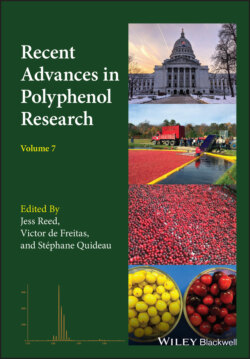Читать книгу Recent Advances in Polyphenol Research - Группа авторов - Страница 40
2.3.6.4 Synthesis of Selligueain A (63)
ОглавлениеThe coupling protocols were applied to the synthesis of selligueain A (63), isolated from the rhizomes of Selliguea feei (Figure 2.28) (Noguchi et al. 2018). Although this compound is interesting because of the pronounced sweetness, 35 times sweeter than sucrose, it had been obtained in only minute amounts from nature. A serious issue was that the trimers are comprised of two rare flavan monomer units, i.e. (–)‐epiafzelechin (EZ) and (+)‐afzelechin (AZ), which manifests a general bottleneck in the chemical synthesis of flavan oligomers – that is, the limited availability of their monomeric constituents. Note that commercially available flavan‐3‐ol is basically limited to (+)‐catechin, and other congeners are scarce and could not be used as the starting materials.
The initial step in the assembly of these monomer units was the annulation of the top unit 64 and the middle unit 65 by using BF3·OEt2 to give 66 as a sole product in 86% yield (Figure 2.29). Importantly, no formation of the C(4)→C(6)‐linked products was observed, and the sulfide moiety remained intact under these hard Lewis acidic conditions. After detachment of the silyl group in 66, the arylthio group in the resulting alcohol 67 was activated under soft Lewis acidic conditions to react with the bottom unit 68. The annulation reaction proceeded the annulation, giving trimer 69 in 93% yield. It should be noted that the seemingly labile benzylic acetal moiety at the C(2) position of the top unit remained untouched. Finally, all benzyl groups and the bromine atom were removed by hydrogenolysis to give pure 63 in 85% yield.
